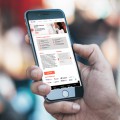6 Things A Great UX/UI Designer Has
— September 3, 2014Nowadays, design extends beyond mere aesthetics; it plays a crucial role in shaping the user experience. Having collaborated with hundreds of designers in web and mobile application development, I have identified certain traits that set truly exceptional designers apart. At S3Corp, we recognize these traits as essential for creating seamless, innovative designs that enhance user engagement. Whether you are a company seeking to hire a designer or an individual aiming to refine your skills, these traits merit careful consideration.
1. Organization: The Foundation of Quality Design
Organization is vital in UX/UI design. An organized designer simplifies complex projects and communicates more clearly with development teams, ensuring everyone is aligned.
Key Traits of Organized Designers:
- Layered Approach: Outstanding designers carefully group and label layers in design software like Photoshop, facilitating collaboration and reducing time spent navigating files.
- Grid Systems: They establish a well-defined grid system to create visually balanced layouts and ensure responsiveness across various devices.
- Folder Structure: Maintaining a consistent and logical folder structure allows designers to keep workflows smooth and minimizes confusion, saving time and ensuring easy file retrieval.
- Consistency in Spacing: Thoughtful designers uphold consistent padding and margins, fostering a harmonious look that enhances user experience and simplifies developers’ tasks.
- Image and Module Planning: The best designers anticipate image sizes and module dimensions in advance, streamlining the design-to-development process and preventing performance issues later.
An organized designer doesn’t just create aesthetically pleasing work; they lay the groundwork for effective collaboration and efficient development.
2. Patience: Designing with Discipline
In a fast-paced industry, patience is an underrated yet essential quality. Great designers understand that design is a process and follow each step diligently to ensure the final product meets high standards.
Key Traits of Patient Designers:
- Detailed User Journeys: Top designers meticulously create user journey diagrams to understand interactions within the system, enabling them to craft intuitive designs that guide users seamlessly.
- Comprehensive Wireframes: Patient designers invest time in developing wireframes, which serve as blueprints for functional and content-rich layouts that establish clear expectations before moving to high-fidelity designs.
- Educators at Heart: They value the design process and are willing to explain their methods, educating clients and colleagues on the design’s purpose and the significance of the journey toward the final product.
With patience, designers can navigate complex projects, refine their ideas over time, and consistently deliver high-quality results.
3. Wide Knowledge: Balancing Business and Technology
Exceptional designers are not only creative but also possess a solid understanding of the business aspects of their work. They recognize that effective design blends aesthetics, functionality, and business needs.
Key Traits of Knowledgeable Designers:
- Business Acumen: Designers who excel invest time in understanding the business model behind each project, including client objectives, the competitive landscape, and end-user needs.
- Mastery of the Business Model Canvas: Experienced designers effectively utilize a business model canvas, often leading efforts to map how design elements fit into the overall business strategy.
- Strategic Prioritization: They know when to prioritize fast turnarounds versus investing time in more refined iterations, helping to manage timelines without compromising quality.
- Technologically Savvy: A great designer embraces the technical side, whether front-end, back-end, or both. They possess a working knowledge of the technologies that underpin their designs, facilitating smoother collaboration with developers.
The best designers understand that their role encompasses more than creating beautiful interfaces; it involves designing systems that meet both business objectives and user needs.
4. Empathy: Understanding the User Experience
Exceptional designers demonstrate empathy, genuinely caring about the individuals who will use their designs. They place themselves in the shoes of both users and collaborators, creating designs that feel intuitive and human-centered.
Key Traits of Empathetic Designers:
- User-Centric Design: Empathetic designers dedicate time to understanding the users’ journey through a website or app, ensuring each interaction is natural and satisfying.
- Developer and Content Empathy: Exceptional designers appreciate the efforts of developers and content creators, promoting a spirit of collaboration. They strive to make their designs practical for developers while remaining delightful for users.
- Adaptability: They are humble enough to recognize when an idea isn’t working. Great designers quickly abandon their concepts if they do not serve the project’s goals, demonstrating a commitment to finding the best solution rather than clinging to their preferences.
- Consultative Approach: Empathetic designers not only understand the needs of others but also possess the courage to provide guidance when certain requests may not yield the best outcomes.
Empathy is crucial for creating authentic user experiences, fostering trust, and building lasting relationships with users.
5. Creativity: Innovating at Every Level
While creativity is often linked to brainstorming new ideas, for designers, it also involves finding innovative solutions to challenges at every project stage.
Key Traits of Creative Designers:
- Solution-Oriented Thinking: Creative designers go beyond surface-level ideas; they explore multiple solutions and continuously refine their approaches until they discover the most effective one.
- Versatility in Design: The best designers can shift their designs in new directions, embracing change as projects develop.
- Learning from Others: They study the work of other designers, using it as inspiration to enhance their own designs.
Creativity in design extends beyond visual elements; it encompasses problem-solving at all phases, ensuring that the final product is both beautiful and functional.
6. Communication: Building Client and Team Relationships
Outstanding designers are also exceptional communicators. They articulate their ideas clearly and foster relationships with clients and colleagues, making them effective consultants.
Key Traits of Communicative Designers:
- Purpose-Driven Design: Great designers consistently ask, “Why am I doing this?” This mindset ensures that their designs align with project goals.
- Persuasive Skills: They can justifiably present their design choices to clients, stakeholders, and team members in ways that resonate with others.
- Presentation Proficiency: A top designer possesses excellent presentation skills, making them invaluable in client meetings and internal brainstorming sessions.
- Challenging Authority: They are unafraid to respectfully question higher-ups for the benefit of the project. This boldness often leads to innovative and user-centric designs.
Effective communication empowers designers to advocate for their work, bridging the gap between client vision and project realities.
Conclusion: The Modern Designer’s Toolkit
Whether you are part of a software development vietnam like S3Corp or a designer aiming to excel in web and mobile application development, these traits are essential. Here’s a brief overview:
- Organization lays the foundation for structured, accessible designs.
- Patience fosters a step-by-step process that respects the creative journey.
- Wide Knowledge enables designers to align their work with business objectives.
- Empathy promotes user-centric designs and a collaborative atmosphere.
- Creativity leads to original and effective solutions at every project phase.
- Communication transforms designers into valuable consultants who can advocate for optimal design choices.
By embodying these traits, designers can consistently deliver exceptional results that not only meet client needs but also enhance the user experience.













